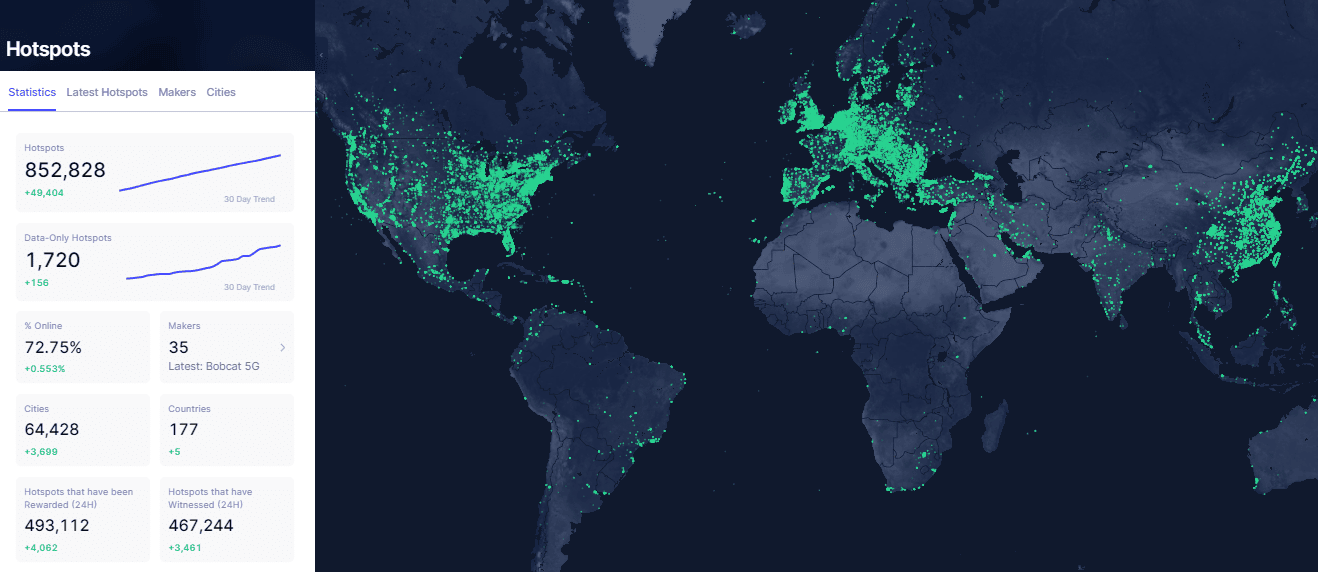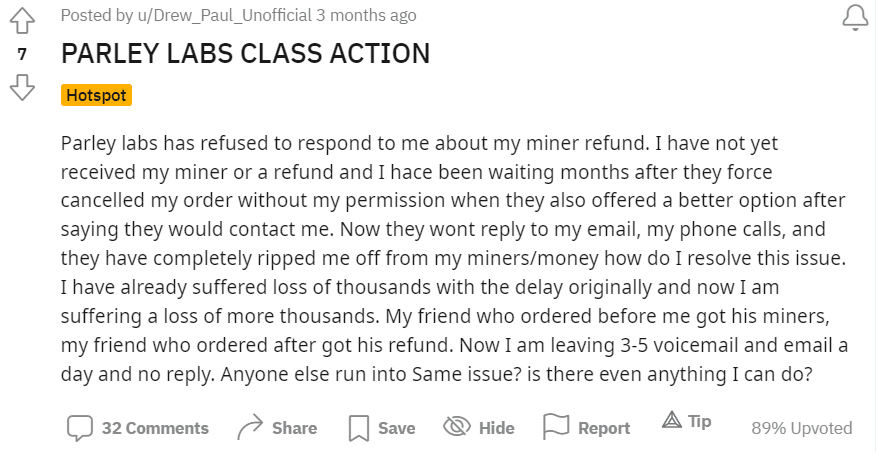Helium is a blockchain-based protocol that’s been garnering a lot of popularity for the past few months in 2022, mostly for being one of the few (if not only) crypto projects tapping into the Internet of Things (IoT) industry, which is worth north of $380 billion.
The helium network is composed of Helium hotspots, which are similar to an internet router that provides broader and cheaper internet access for everyone.
While most cryptocurrency projects are focused on NFTs or blockchain gaming, Helium distinguishes itself for a few reasons:
- Provides cheap internet access with wide bandwidth coverage, including 5G
- It’s a VC darling-attracting investments from funds such as a16z and Tiger Global
- Allows users to generate revenue by running a Helium hotspot
In this article, let’s explore what the Helium blockchain is, how it works, and everything you need to know about this protocol.
What is Internet of Things (IoT)?
Before we dive in on what Helium is, It’s important to understand what Internet of Things is.
IoT describes a network of physical objects embedded with sensors and other softwares. Any technology that connects and transmits data with other devices, systems, or networks (such as smart fridges, smartphones, electric scooters) is under the IoT umbrella.
IoT is an addressable market worth upwards of $384 billion, and Helium is one of the front-runners of the crypto niche attempting to win a slice.
Now that we have an idea of what IoT is, let’s explore what role Helium plays in this market.
What is Helium?
Helium is a blockchain-based protocol running a wireless global network of IoT devices and provides them with long-range connectivity via Helium Hotspots. These hotspots are similar to an internet router that users can plug into an outlet and earn Helium’s native token, HNT, which is tradable on exchanges for real-world money.
How Does Helium Work?
Hotspots are the fundamental pillars of the Helium network as they provide connectivity for IoT devices. The closer a hotspot is to another hotspot, the better, as not only makes the network denser and provides wider coverage but also increments rewards to the owner.
These hotspots act as nodes, allowing IoT devices to send and receive data between them and also secure the Helium blockchain. When users plug a hotspot into an outlet and run it, they start mining HNT, which is rewarded to them as an incentive.
How to Set up a Helium Crypto Mining Hotspot
Setting up a hotspot is very straightforward: you buy a hotspot and set it up in your office or home by simply plugging it into an electric outlet and then connecting it to an internet provider. This way, you are able to provide low-power network coverage for IoT devices so individuals and businesses can seamlessly connect.
Doing so rewards you with HNT, but as previously stated, rewards could increase or decrease depending on several factors, the most important being distance: the closer your hotspot is to other hotspots, the better, as rewards increase significantly. The idea is to make a dense network that can provide wide coverage for IoT devices.
Helium Features and Components
Here we are diving deeper into Helium’s key technological components and features.
What is Helium LongFi?
LongFi is simply the proprietary name of the Helium network. LongFi is the combination between the Helium blockchain and the LoRaWan architecture. And what is LoRaWan?
LoRaWan (Low-power wide-area network) refers to a distributed architecture sitting on top of a physical layer called LoRa (short for long range) which provides wireless, low-power communication links for IoT devices.
Helium Proof of Coverage
Now that we have explained how Helium hotspots work, let’s look at how the Helium network is powered: the proof-of-coverage (PoC) consensus mechanism.
The PoC consensus algorithm allows nodes (hotspots) to communicate with each other via radio frequency. It constantly tests hotspot nodes using a mechanism called PoC Challenge to verify that the hotspot nodes are where they claimed to be.
The Challenge has three key roles, each receives a portion of HNT for carrying out their specific task :
- Challenger: also known as the Transmitter, is the validator in charge to execute the PoC Challenge.
- Beaconer (Challengee): the target being tested. The challengee needs to submit what’s called “challenge packets” as proof of work.
- Witness: in charge of validating the Beaconer’s challenge packets and submitting them to the Transmitter.
The Helium network can punish nodes that act maliciously, for example: preventing other nodes in a consensus group from performing their tasks. The number of rewards that a punished validator receives decreases considerably, not to mention they can lose the chance to participate in consensus groups.
Helium and the aBFT Consensus
The PoC mechanism leverages the HoneyBadger BFT (HBBFT) consensus, which is an asynchronous Byzantine Fault Tolerant (aBFT) algorithm. It allows network nodes to reach consensus by themselves without worrying about time assumptions. In simpler words, nodes are capable of executing commands at their time and speed without waiting for nodes to reach an agreement.
This enables the network to run without disruption and process a larger number of transactions.
Helium’s Tokenomics: How does the HNT Token Work?
HNT is Helium’s native cryptocurrency and it’s used to reward hotspots operators for their work. Helium uses a tokenomic model called burn-and-mint equilibrium (BME). This is a multi-token mechanism, and in Helium’s case, has two units of exchange:
- HNT: tradable tokens capable of accruing value over time. The total market supply is 223 million HNT.
- Data Credits (DC): these are non-transferable tokens, meaning that the user is paying for a service and not sending them to anyone in the network. This is similar to pre-paid mobile data or airline miles.
Data Credits allow devices to send data to the Helium LongFi protocol and users to pay for network fees. Each of these tokens is pegged to the US dollar and has a fixed value of $0.00001.
Helium users can convert HNT to acquire Data Credits. This process, known as “burning” eliminates the converted HNT from circulation. Of course, this causes fluctuation in HNT’s market capitalization — as network activity grows, more HNT tokens are burned, increasing in value.
A new block is created each minute, while the network distributes HNT rewards every 30 blocks. The HNT production rate is halved every two years. During the Genesis block (the first block ever mined in a blockchain) Helium was producing 5 million HNT per month. Last August it was reduced to 2.5 million HNT/month.
Helium Token Price History
The Helium team didn’t pre-mine the HNT tokens at first in order to create a fair distribution to the community. According to data from Messari, HNT peaked at $54.81 in mid-November 2021. As of June 2022, the HNT token is trading at $9.35 apiece.
Helium History & Founders
Behind the Helium blockchain is Helium Inc. launched in 2013 as a telecommunications startup, headquartered in San Francisco, California, United States. Amir Haleem and Shawn Fanning are the founders and current CEOs.
In 2019, Helium pivoted into the cryptocurrency world and witnessed moderate success. It would experience a massive boom in early 2021, going from roughly 15,000 hotspots worldwide to nearly a million by January.
On March 30, 2022, the founders rebranded Helium Inc. as Nova Labs, after it secured a $200M Series D funding round led by various VC funds including Andreessen Horowitz (a16z) and Tiger Global.
As of June 2022, there are over 850,000 hotspots operating across 177 countries, according to the protocol’s analytics platform, Helium Explorer.

What Makes Helium’s Entry to Crypto Unique?
Helium’s success is largely based on the fact that they give people access to cheaper internet access compared to cellular data, while also providing users with a means to make a passive income by mining HNT.
Hotspots owners do not need to buy any additional hardware components — like SIM cards — and they only pay for data usage and not for extra fees or hidden costs
Helium has become a darling for VC funds and wealthy investors in 2022. Leigh Drogen, CIO at digital assets hedge fund Starkiller Capital, said Helium’s market capitalization could be “half or more the market cap of something like Verizon.”
Downsides and Risks Associated With Helium
For starters, there are possible supply chain delays when buying a Helium hotspot. Several would-be miners have been left out from participating in the ecosystem for not receiving their hotspot devices on time, and some of them have complained about extreme delays that would last nearly a year and without receiving a refund after the order was canceled.
One could partially attribute the delays to a global chip shortage and supply chain problems. Whichever the reason, there’s a chance that you might find yourself in this uncomfortable situation, so plan accordingly.
Final Thoughts: The Future of the Helium Protocol
Helium has become a popular option for users who want to provide coverage to IoT devices and mine cryptocurrency in the process. It’s also a more environmentally-friendly proof-of-work ecosystem compared to other protocols out there.
Despite the setbacks, Helium keeps scaling and growing its user base globally. It’s becoming a pioneer in the IoT industry by providing an easy-to-use infrastructure that can tackle the current challenges regarding IoT connectivity.






